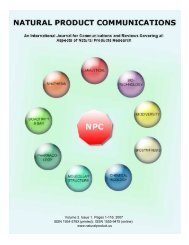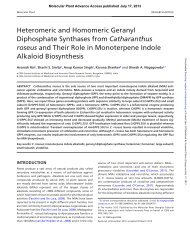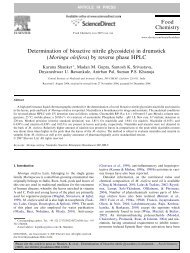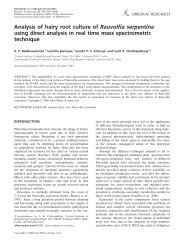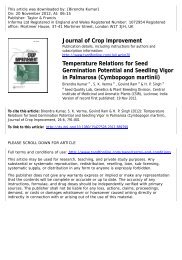Rose-scented geranium - CIMAP Staff - Central Institute of Medicinal ...
Rose-scented geranium - CIMAP Staff - Central Institute of Medicinal ...
Rose-scented geranium - CIMAP Staff - Central Institute of Medicinal ...
You also want an ePaper? Increase the reach of your titles
YUMPU automatically turns print PDFs into web optimized ePapers that Google loves.
218 Plant Cell Tiss Organ Cult (2007) 90:215–223RAPD analysis was done according to the protocol byShoyama et al. (1997). Two transgenic plants (2TGand 14TG) were analyzed in replicates in order todemonstrate genetic uniformity within the clone.Results and discussionA transformation frequency from leaf explants wasthe highest, followed by the petioles and internodalsegments (Table 2). However, young leaf petioles didnot produce hairy roots in any <strong>of</strong> the Pelargoniumspecies tested (Pellegrineschi and Mariani 1996).Although transformation frequencies was high withboth the bacterial strains used in this study, as hasalso been reported in lemon-<strong>scented</strong> <strong>geranium</strong> (Pellegrineschiet al. 1994). Amongst the two bacterialstrains used, A 4 proved to be effective than LBA9402, both in terms <strong>of</strong> frequency <strong>of</strong> response and timerequirement for hairy-root induction (Table 2). Similarobservations had also been reported earlier fordiverse plant species (Porter 1991; Rodrigues et al.1991; Banerjee et al. 1994; Giri 1997; Zehra 1998).In view <strong>of</strong> the fact that each transformation eventis distinct from the other due to different integrationsites and copy numbers <strong>of</strong> Ri T-DNA (Tepfer 1984),90 independent hairy-root lines <strong>of</strong> A 4 origin and 60 <strong>of</strong>LBA 9402 origin were selected for regenerationstudies (Fig. 1A). Amongst these, 14 regenerants byA 4 and seven root lines by LBA 9402 origin showedspontaneous regeneration without the interveningcallus phase within 8–10 weeks <strong>of</strong> subculturing inhormone-free liquid and semi-solid MS medium(Fig. 1B and C; Table 1). Spontaneous regeneration<strong>of</strong> plants from hairy root cultures has already beenreported in Pelargonium (Pellegrineschi et al. 1994;Pellegrineschi and Mariani 1996; Banerjee et al.1997; Perez-Morphe-Balch and Ochoa-Alejo 1987).Direct organogenesis was observed in 26 and 13 <strong>of</strong>the hairy root lines <strong>of</strong> A 4 and LBA 9402 origin,respectively (Table 3), within 6–8 weeks <strong>of</strong> culturewith different hormonal combinations.Only two <strong>of</strong> the five regeneration media testedwith varying concentrations <strong>of</strong> NAA and BAPresponded both in their semi-solid and liquid state.A maximum <strong>of</strong> 6–8 shoots per root explant wasproduced after 7 weeks <strong>of</strong> culture containing 0.5 mg/lBAP and 0.1 mg/l NAA (Table 1). These concentrationswere lower than those as reported in regalPelargonium (Pelargonium · domesticum Dubonnet)(Boase et al. 1998). Various combinations <strong>of</strong> differenthormones including NAA, BAP, zeatin as well assupplementary vitamin source and PVP-10 have beenused for inducing direct and indirect regeneration <strong>of</strong>transgenic shoots through transformation with A.tumefaciens in leaf discs <strong>of</strong> Zonal (Pelargonium· hortorum) and <strong>scented</strong> (P. capitatum)<strong>geranium</strong> (Hassanein et al. 2005).It is pertinent to mention here, that in addition todifferent hormonal combinations, reduction in theconcentrations <strong>of</strong> sucrose as well as that <strong>of</strong> othernutrients to half appears to be an essential prerequisite<strong>of</strong> the present study in order to optimize the shootregeneration efficiency from hairy root cultureswhich has not been considered earlier (Boase et al.1998).All the transgenic plantlets <strong>of</strong> the present study,irrespective <strong>of</strong> their spontaneous or hormone-mediatedorigin, exhibited spontaneous rhizogenesis upontransfer to hormone-free half strength MS mediumwithin 2 weeks <strong>of</strong> transfer (Fig. 1E).A total <strong>of</strong> 11 transgenic plants out <strong>of</strong> the total36 tested were successfully transferred to theglasshouse. The leaves <strong>of</strong> all transformed plantswere darker in colour, more dentated and leafwrinkling was absent in all <strong>of</strong> them as has also beenreported earlier (Pellegrineschi et al. 1994).The transformants also had highly branched rootsystems, shorter internodes, increased number <strong>of</strong>leaves and branches and short and round stature <strong>of</strong>Table 2 Susceptibility <strong>of</strong>different explants <strong>of</strong>Pelargonium graveolens cv.Hemanti to A 4 and LBA9402 strains <strong>of</strong>Agrobacterium rhizogenesBacterial strainsTransformation frequencyInternode Petiole LeafA 4 50 ± 3.2 71.3 ± 3.3 100 ± 0.0LBA 9402 20 ± 1.9 50 ± 2.6 82 ± 4.1123




